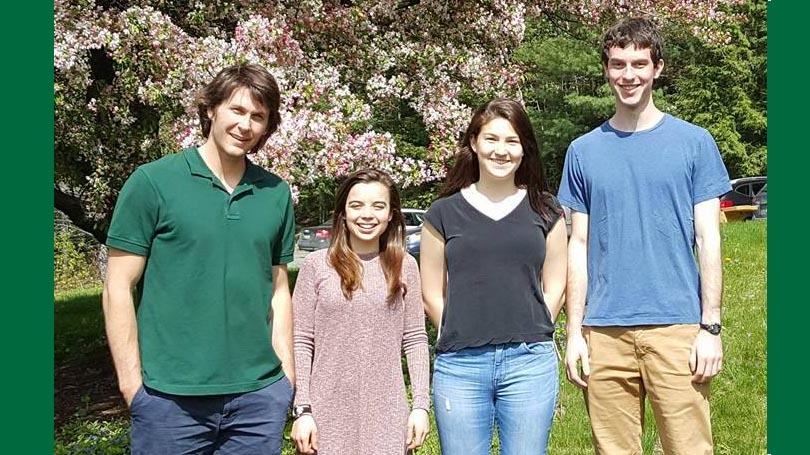Thanks to advances in microelectronics, the typical smart phone today has more computing power than the first moon lander. Microelectronics involves the fabrication of minute electronic components with features on the micrometer scale or smaller. These advances are known to be slowing, and a collaboration between the Department of Chemistry and Thayer School of Engineering, led by Katherine A. Mirica, Assistant Professor of Chemistry, and Douglas W. Van Citters, Assistant Professor of Engineering at Thayer School of Engineering, have an innovative solution that may keep the microelectronics industry advancing.
The solution to the problem was to introduce a new method of temporary adhesion by using a group of compounds capable of subliming — directly transforming from a solid to a gas (like moth balls or dry ice) — as adhesives. These sublimable adhesives are implemented in a similar manner to other glues, bonding the surfaces together once cured. The novelty lies in using sublimable small molecules (in stark contrast to the typical polymeric adhesives encountered in glues, tapes, and caulks) while achieving strong adhesion (comparable to tape and Krazy glue). With their first paper on the project published in February in Chemistry of Materials, the group now looks toward expanding the breadth of their adhesives and understanding the fundamental science at hand.
In addition to Mirica and Van Citters, the research team consists of two graduate students Haydn T. Mitchell and Nicholas D. Blelloch, postdoctoral researcher Merry K. Smith, and two freshman undergraduate interns Carly C. Tymm ‘20 and Louisa C. Greenburg ’20 sponsored by the Women In Science Project (WISP).
Tymm and Greenberg are both Chemistry majors who choose Dartmouth for its undergraduate focus, tight-knit community, and scenic location. They both knew they wanted to do research in college and the WISP program was a great way to “accelerate the process” of getting involved. “I hadn’t done research and wanted to see if I would like it and if it would influence what I would want to do later on,” notes Greenberg.
Both Tymm and Greenberg have a tenacity for learning and believe their work and research have been strengthened by the WISP intern experience. Tymm commented on the “exciting opportunities to learn things outside of the classroom” and says it has allowed her to “tie together things [she] was learning in chemistry and mathematics courses with real world applications.” Greenberg similarly has been excited to apply the chemistry techniques she has learned in class to her research. She remarked “I’m actually learning these skills in my class that I can then use in the research lab.” The interns have also gained new scientific techniques and skills for data organizing and analysis.
Tymm and Greenburg are paired up to work with Mitchell and Blelloch respectively in the laboratory, a collaboration that synergizes the undergraduate and graduate learning experience: the graduate students can hone their mentoring skills, while the undergraduates learn about the scientific process through guided inquiry and rigorous safety oversight in the chemical laboratory. Mitchell and Blelloch are first year graduate students coming from different backgrounds. After Mitchell finished his MS in Polymers and Coatings Science at California Polytechnic State University, San Luis Obispo, CA, he cofounded a chemical company, MegaMatter, that produces nontoxic flame retardants. “I have enjoyed bringing my application-based experience in materials science to the project while being challenged to understand the fundamentals of molecular solids,” he said of the experience. Blelloch graduated from Middlebury College in 2016 where he acquired synthesis skills working on organic nanowire synthesis with Jeffrey H. Byers, a Dartmouth PhD. Blelloch, coming from a primarily undergraduate institute has been “glad to have had the opportunity to mentor undergraduates.”
There was mentoring and exchange of knowledge between numerous members of the group. Mitchell was appreciative of how Smith “was a crucial component in teaching [him] how to research fundamental science.” In addition, Smith brought her knowledge of computational and experimental methods from her PhD at Wesleyan University and her postdoc at the University of Houston to the team. “It’s been terrific to be a part of such a diverse team, and to have the opportunity to transfer my fundamental skills to a more application-based project,” she said.
Dartmouth College celebrates scientific research on campus each May with a science symposium named for the late Professor Karen E. Wetterhahn, a dedicated teacher and mentor who played an integral role in the administration of the sciences at Dartmouth and co-founded Dartmouth's Women in Science Project. “It is an honor to have the opportunity to continue Wetterhahn’s legacy in my laboratory through mentoring of WISP interns” says Mirica. “Working side-by-side with graduate students in a research laboratory is an important enhancement of our undergraduate curriculum that helps the students to make an important transition towards pushing the scientific frontier,” she noted. The team's work will be presented during the poster session at the Wetterhahn Symposium on Wednesday, May 24 2017.
Read more about this year’s Symposium in this Dartmouth Now article.
